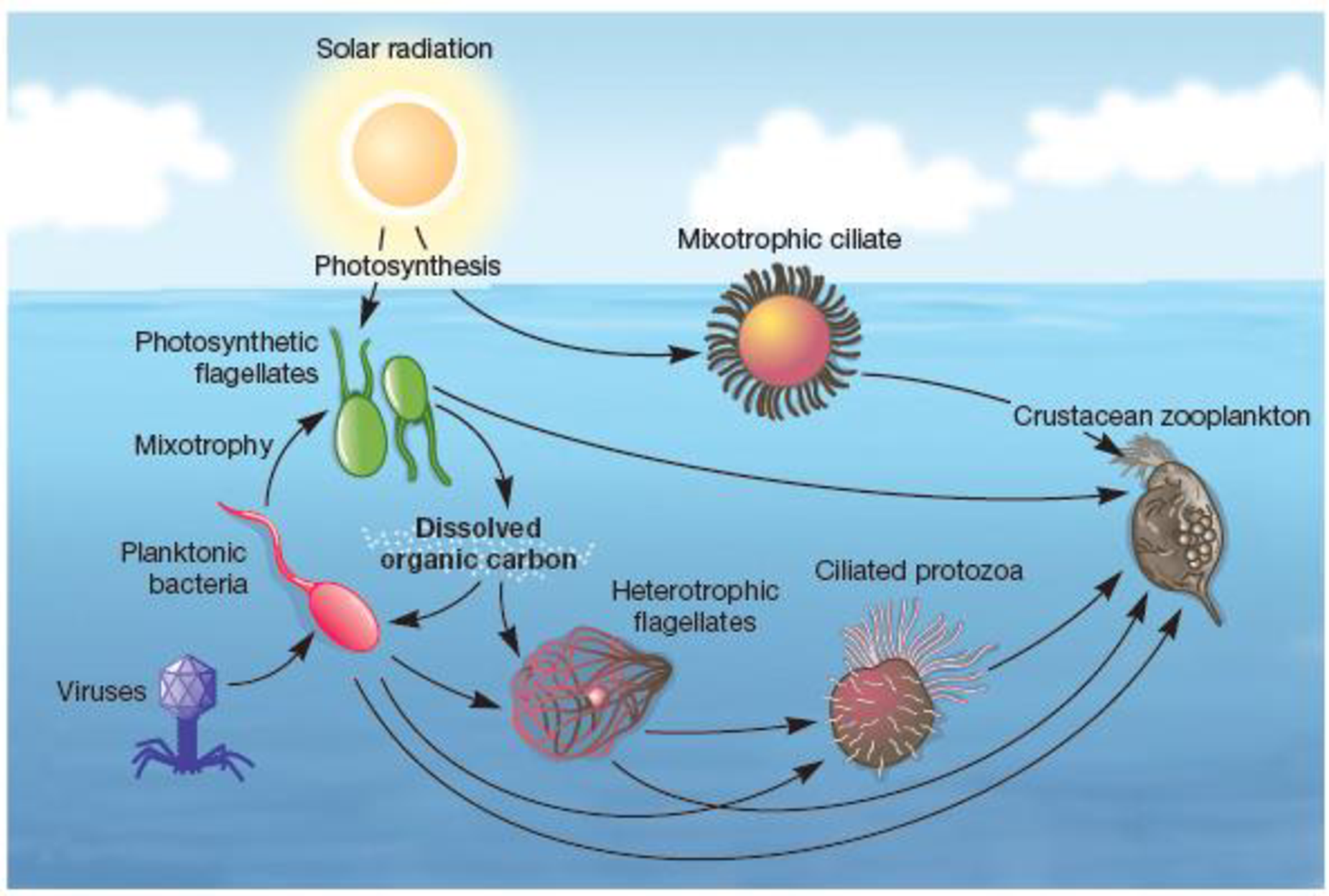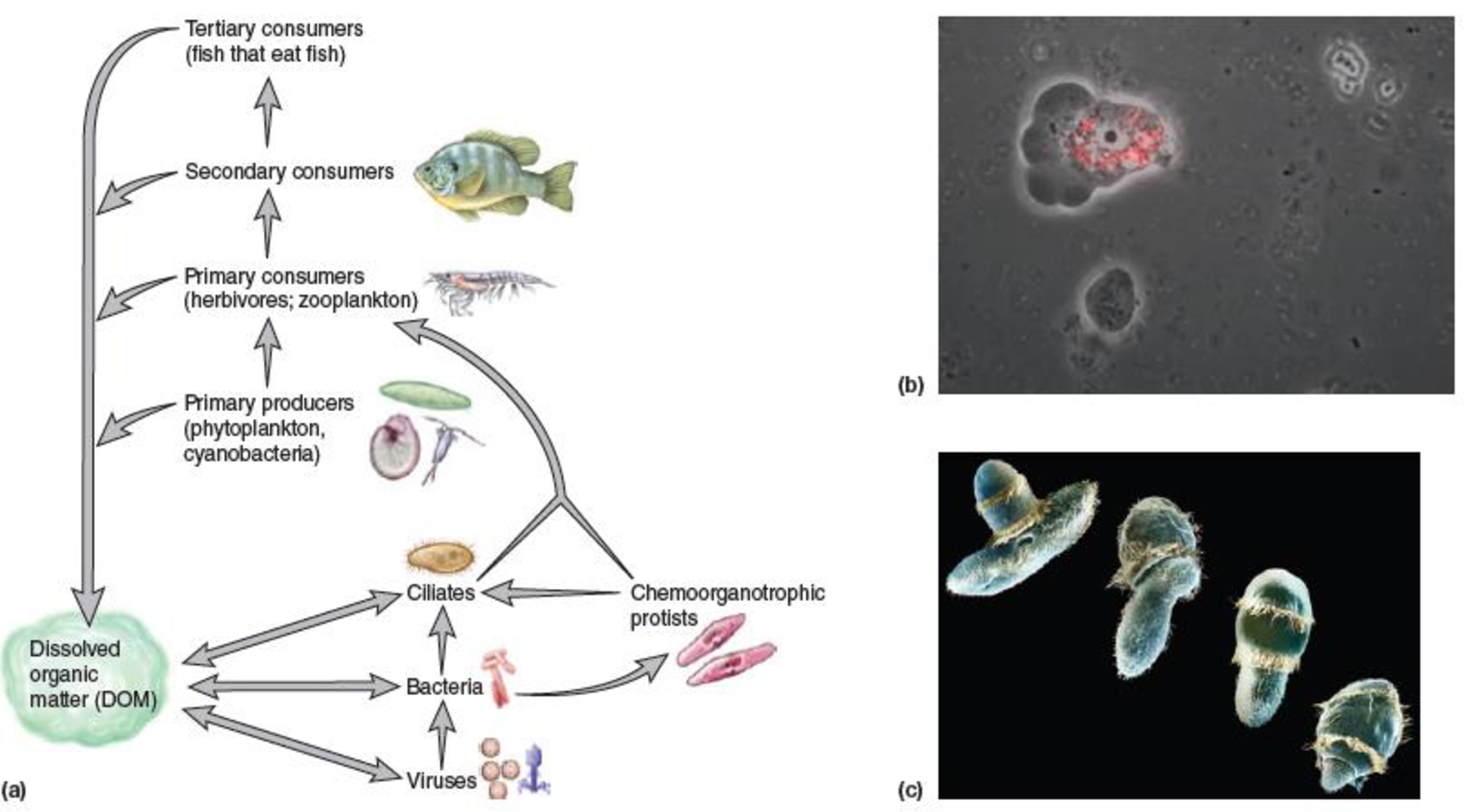
Concept explainers

Figure 30.15 Nutrient Cycling in Antarctic Lakes Is Performed Entirely by Microbes. Antarctic glacial lakes lack multicellular organisms, so all nutrient cycling is between various types of microbes, including bacteriophages. The surrounding environment provides some organic carbon.
List three major differences between this microbial loop and that found in the open ocean (figure 30.6).

Figure 30.6 The Microbial Loop. (a) Microorganisms play vital roles in ecosystems as primary producers, decomposers, and primary consumers. All organisms contribute to a common pool of dissolved organic matter (DOM) that is consumed by microbes. Viruses contribute DOM by lysing their hosts, and bacterial and archaeal cells are consumed by protists, which also consume other protists. These microbes are then consumed by herbivores that often select food items by size, thereby ingesting both heterotrophic and autotrophic microbes. Thus nutrient cycling is a complex system driven in large part by microbes. (b) Protists consume bacteria; in this case, a naked amoeba is consuming the cyanobacterium Synechococcus sp. which fluoresces red. (c) Protists consume protists; here, the ciliate Didinium sp. (rounded organism with two rows of cilia) is preying upon another ciliate, Paramecium sp.
Want to see the full answer?
Check out a sample textbook solution
Chapter 30 Solutions
Connect With Learnsmart Labs Online Access For Prescott's Microbiology
- Noggin mutation: The mouse, one of the phenotypic consequences of Noggin mutationis mispatterning of the spinal cord, in the posterior region of the mouse embryo, suchthat in the hindlimb region the more ventral fates are lost, and the dorsal Pax3 domain isexpanded. (this experiment is not in the lectures).a. Hypothesis for why: What would be your hypothesis for why the ventral fatesare lost and dorsal fates expanded? Include in your answer the words notochord,BMP, SHH and either (or both of) surface ectoderm or lateral plate mesodermarrow_forwardNot part of a graded assignment, from a past midtermarrow_forwardNot part of a graded assignment, from a past midtermarrow_forward
- please helparrow_forwardWhat does the heavy dark line along collecting duct tell us about water reabsorption in this individual at this time? What does the heavy dark line along collecting duct tell us about ADH secretion in this individual at this time?arrow_forwardBiology grade 10 study guidearrow_forward
 Biology 2eBiologyISBN:9781947172517Author:Matthew Douglas, Jung Choi, Mary Ann ClarkPublisher:OpenStax
Biology 2eBiologyISBN:9781947172517Author:Matthew Douglas, Jung Choi, Mary Ann ClarkPublisher:OpenStax Concepts of BiologyBiologyISBN:9781938168116Author:Samantha Fowler, Rebecca Roush, James WisePublisher:OpenStax College
Concepts of BiologyBiologyISBN:9781938168116Author:Samantha Fowler, Rebecca Roush, James WisePublisher:OpenStax College
 Biology: The Dynamic Science (MindTap Course List)BiologyISBN:9781305389892Author:Peter J. Russell, Paul E. Hertz, Beverly McMillanPublisher:Cengage Learning
Biology: The Dynamic Science (MindTap Course List)BiologyISBN:9781305389892Author:Peter J. Russell, Paul E. Hertz, Beverly McMillanPublisher:Cengage Learning Biology (MindTap Course List)BiologyISBN:9781337392938Author:Eldra Solomon, Charles Martin, Diana W. Martin, Linda R. BergPublisher:Cengage Learning
Biology (MindTap Course List)BiologyISBN:9781337392938Author:Eldra Solomon, Charles Martin, Diana W. Martin, Linda R. BergPublisher:Cengage Learning





